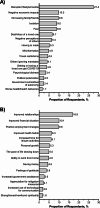Positive and negative aspects of the COVID-19 pandemic among a diverse sample of US adults: an exploratory mixed-methods analysis of online survey data
- PMID: 38166883
- PMCID: PMC10762906
- DOI: 10.1186/s12889-023-17491-w
Positive and negative aspects of the COVID-19 pandemic among a diverse sample of US adults: an exploratory mixed-methods analysis of online survey data
Abstract
Background: The COVID-19 pandemic had a profound social and economic impact across the United States due to the lockdowns and consequent changes to everyday activities in social spaces.
Methods: The COVID-19's Unequal Racial Burden (CURB) survey was a nationally representative, online survey of 5,500 American Indian/Alaska Native, Asian, Black/African American, Latino (English- and Spanish-speaking), Native Hawaiian/Pacific Islander, White, and multiracial adults living in the U.S. For this analysis, we used data from the 1,931 participants who responded to the 6-month follow-up survey conducted between 8/16/2021-9/9/2021. As part of the follow-up survey, participants were asked "What was the worst thing about the pandemic that you experienced?" and "Was there anything positive in your life that resulted from the pandemic?" Verbatim responses were coded independently by two coders using open and axial coding techniques to identify salient themes, definitions of themes, and illustrative quotes, with reconciliation across coders. Chi-square tests were used to estimate the association between sociodemographics and salient themes.
Results: Commonly reported negative themes among participants reflected disrupted lifestyle/routine (27.4%), not seeing family and friends (9.8%), and negative economic impacts (10.0%). Positive themes included improved relationships (16.9%), improved financial situation (10.1%), and positive employment changes (9.8%). Differences in themes were seen across race-ethnicity, gender, and age; for example, adults ≥ 65 years old, compared to adults 18-64, were more likely to report disrupted routine/lifestyle (37.6% vs. 24.2%, p < 0.001) as a negative aspect of the pandemic, and Spanish-speaking Latino adults were much more likely to report improved relationships compared to other racial-ethnic groups (31.1% vs. 14.8-18.6%, p = 0.03).
Discussion: Positive and negative experiences during the COVID-19 pandemic varied widely and differed across race-ethnicity, gender, and age. Future public health interventions should work to mitigate negative social and economic impacts and facilitate posttraumatic growth associated with pandemics.
Keywords: Age; COVID-19 pandemic; Economic impact; Gender; Posttraumatic growth; Race-ethnicity; Relationships; Social impact; Telework.
© 2023. This is a U.S. Government work and not under copyright protection in the US; foreign copyright protection may apply.
Conflict of interest statement
The authors declare no competing interests.
Figures



Similar articles
-
Racial and ethnic disparities in the association between financial hardship and self-reported weight change during the first year of the pandemic in the U.S.Int J Equity Health. 2024 Jan 22;23(1):12. doi: 10.1186/s12939-023-02093-0. Int J Equity Health. 2024. PMID: 38254081 Free PMC article.
-
Inability to get needed health care during the COVID-19 pandemic among a nationally representative, diverse population of U.S. adults with and without chronic conditions.BMC Public Health. 2023 Sep 26;23(1):1868. doi: 10.1186/s12889-023-16746-w. BMC Public Health. 2023. PMID: 37752511 Free PMC article.
-
Racial and Ethnic Differences in COVID-19 Outcomes, Stressors, Fear, and Prevention Behaviors Among US Women: Web-Based Cross-sectional Study.J Med Internet Res. 2021 Jul 12;23(7):e26296. doi: 10.2196/26296. J Med Internet Res. 2021. PMID: 33819909 Free PMC article.
-
Race and Ethnicity Representation in Phase 2/3 Oncology Clinical Trial Publications: A Systematic Review.JAMA Health Forum. 2024 Jun 7;5(6):e241388. doi: 10.1001/jamahealthforum.2024.1388. JAMA Health Forum. 2024. PMID: 38848090 Free PMC article.
-
Sex, Racial, and Ethnic Representation in COVID-19 Clinical Trials: A Systematic Review and Meta-analysis.JAMA Intern Med. 2023 Jan 1;183(1):50-60. doi: 10.1001/jamainternmed.2022.5600. JAMA Intern Med. 2023. PMID: 36469312 Free PMC article.
Cited by
-
Recognising the heterogeneity of Indigenous Peoples during the COVID-19 pandemic: a scoping review across Canada, Australia, New Zealand and the USA.BMJ Public Health. 2024 Dec 30;2(2):e001341. doi: 10.1136/bmjph-2024-001341. eCollection 2024 Dec. BMJ Public Health. 2024. PMID: 40018612 Free PMC article.
References
-
- Centers for Disease Control and Prevention. COVID Data Tracker. Atlanta, GA: U.S. Department of Health and Human Services, CDC. 2023. https://covid.cdc.gov/covid-data-tracker. Accessed 28 June 2023.
-
- Tedeschi RG, Shakespeare-Finch J, Taku K, Calhoun LG. Posttraumatic growth: theory, research, and applications. Routledge; 2018.
MeSH terms
LinkOut - more resources
Full Text Sources
Medical
Research Materials

